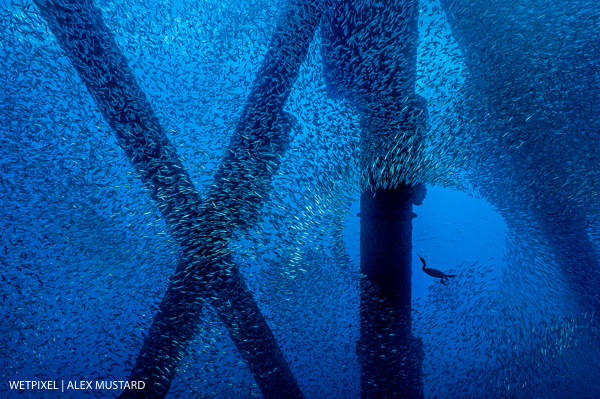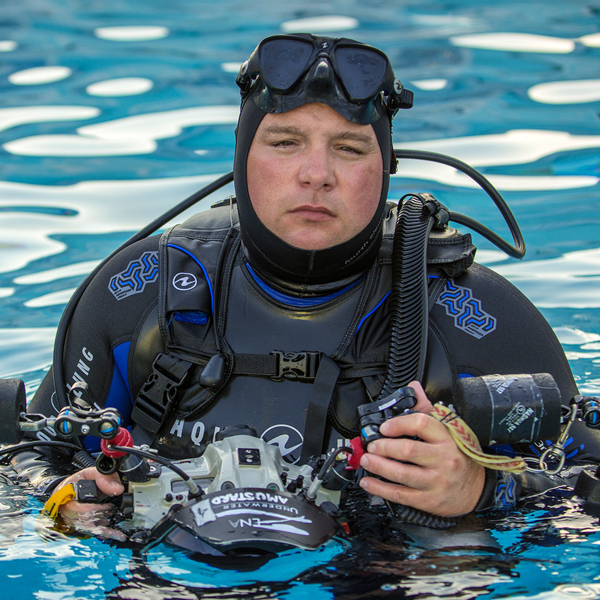Close Focus: Rig Diver by Alex Mustard
Close Focus: The story behind the image.
“The old photographic adage that the most important piece of equipment is the nut that holds the camera is particularly true underwater. Not only are you the photographer, you are also the tripod, transport and hide. This places sizeable demands on your diving abilities. Probably the most fundamental advice in these pages is to dive for your pictures, not just take photos while you dive. Make photography the purpose of your diving and you are on the right track to excellence.” from Underwater Photography Masterclass by Alex Mustard
Rig Diver – Alex Mustard
Underwater photographers talk much more about gear and settings than they do about the planning, preparation and dedication that is perhaps even more important in producing memorable images. The aim of this new series of articles is to redress the balance and go beyond the camera-speak and reveal what’s required to produce outstanding images when diving.
Great underwater images often rely on good fortune, but rarely happen by accident. Those special shots often start with decision made weeks or months earlier. They almost always require diving to be focused on photography, so that plans can be changed and opportunities can be given the time they deserve. My photo shows a cormorant hunting chub mackerel beneath an oil rig, in 700 feet of water in the Pacific Ocean, off Los Angeles.

Although my main focus for visiting California was to shoot the kelp forests of the Channel Islands, I definitely wanted to dive the rigs. Initially this was just for the very unusual experience of being allowed to dive beneath a working oil rig. But as I studied other photographers’ photos from the site, this soon turned to a strong photographic lust! I will always spend time looking at other photographers images prior to visiting a new locations, and try and think about the opportunities and challenges, so I am ready as possible for the shoot.
One thing that struck me was that in some images the legs of the rig were packed with schooling fish and a few messenger chats with SoCal friends revealed this tended to be seasonal event. So I planned my trip for September, to catch hopefully the best conditions on the rigs and the kelp. And headed out to shoot the rigs with locals Todd Winner, Brook Peterson and Michael Zeigler.
Initially, we only planned a brief visit to the rig, so that I could cross it off the dive bucket list, but it was obvious after our first dive that we had caught great conditions and big schools and we ended up making 6 dives there.
The schools themselves were beautiful as they weaved between the legs of the rig, but I felt that an image of a predator splintering the fish would be more dynamic. Pictures that capture a very specific moment of action or gesture are especially compelling.
The two main predators that day were sea lions and cormorants and I shot both, although I focused on the birds because they were so remarkable in the water. I even watched one overtake and steal the fish that a sea lion had singled for a meal!
The final piece of the photographic puzzle was switching away from my fisheye lens. My first shots had caught the action, but the fisheye lens made all the legs of the rig bendy. Changing to the 20mm lens kept the legs straight and helped to tell this food chain story in this most unusual setting.

Award winning photographer Alex Mustard is an Associate Editor of Wetpixel, writes the monthly IMAGES Column in Sport Diver magazine and is the author of the popular book Underwater Photography Masterclass.